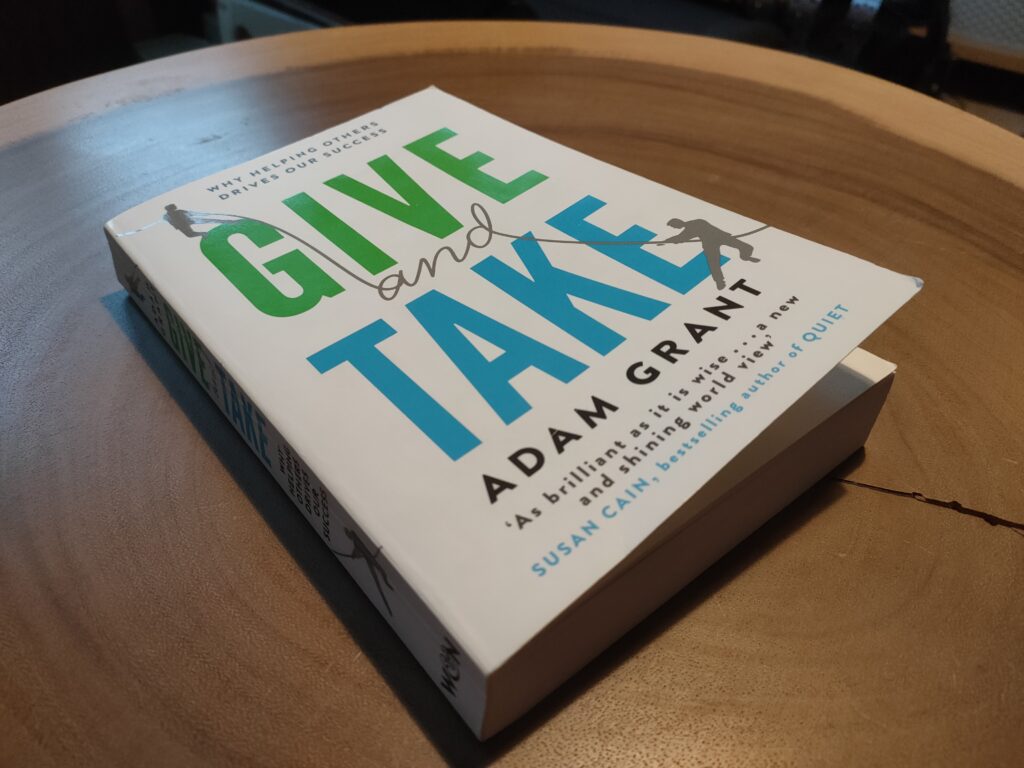
On the first ever album that I bought, the opening track is titled with a famous phrase…
“Nice guys finish last”.
(A prize to the person that adds the name of that album in the comments – no Googling) 🙂
Just like extroverts supposedly get all of the advantages in their careers over introverts, popular media leads us to believe that the way to get ahead is by being a selfish arse, rather than being someone who genuinely cares about others.
And there’s an ounce of truth in this. I’m sure all of us have encountered such people:
- Those that only ever seem to think about themselves
- Those who are happy to receive favours, but never return them
- Those that thrive on status, money and ego, and who do anything to get what they want
And the frustrating thing is, they often manage to do so.
Yet, in Give and Take, Wharton Business School professor Adam Grant attempts to argue that there is a different way.
He suggests that being a ‘Giver’ (i.e. the complete opposite of a ‘Taker’ – i.e. the person I’ve described above) actually has better career benefits in the long-term, let alone make the world a nicer place for everyone!
If this sounds intriguing, read on to find out our top three takeaways from Give and Take:
1. Takers aren’t as successful as you may think
2. Being a completely altruistic giver can lead to burnout
3. Givers succeed long-term due to thinking ‘bigger picture’
1. Takers aren’t as successful as you may think
The early stages of the book describe the differences between Givers, Takers, as well as ‘Matchers’. In summary…
Takers
Those who are typically self-centered, focusing only on their own success and the benefits they can personally gain from any situation. They favour things like wealth, power, and winning, and will often describe situations with ‘I’ rather than ‘we’.
Givers
Those who are inherently generous, providing their help or guidance whilst expecting absolutely nothing in return. They favour things like helpfulness, responsibility and compassion, and will actively seek to elevate others over themselves.
Matchers
These sit somewhere in between Givers and Takers, generally taking a “I’ll do something for you if you do something for me” approach. Their mentality is all about fairness and balance. Unsurprisingly, the majority of the population fall into this category.
Interestingly, studies show that Givers sit at both the bottom and the top of the career success ladder. In other words, some of the very best, and some of the very worst performers are Givers, whilst the Takers and Matchers tend to sit someone in the middle.
Sounds confusing right?
As the book goes on, Grant explores how the ‘style’ of giving can have an impact here. Whilst some Givers fall into ‘doormat’ territory (i.e. where every single action they take is to assist someone else), the most successful Givers still manage to balance their giving approach with taking time for their own needs.
And this leads us nicely onto the next point…
2. Being a completely altruistic giver can lead to burnout
Whilst falling into ‘doormat’ territory can end up having a negative effect on your own career (although it will make you a very lovely person), Grant argues that there is another way.
Remember – there’s a reason that an airline will ask you to put on your own oxygen mask before helping others!
Many leaders like to spout nonsense about being ‘altruistic’ as it looks good for their LinkedIN and internal PR. But being 100% altruistic all of the time means you put yourself last 100% of the time.
The reality is that you NEED to give yourself attention at least some of the time, or there’s a very real risk of burning out.
In the latter part of the book, Grant goes on to describe ‘Otherish’ Givers; essentially people who have realised that they can still advance their career without being completely altruistic. Whilst their default is to support others, they also make time to help themselves, and focus on their own ambitions and interests.
3. Givers succeed long-term due to thinking ‘big picture’
With the book focusing on the benefits of being a Giver, it’s unsurprising that there are many great examples of giving throughout the book.
One example explores how Abraham Lincoln, before becoming president, dropped out of a senate election race to let a rival win, aware that both he and his competitor shared the goal of abolishing slavery.
Ultimately, Lincoln knew that his bigger ambition was far more likely to be achieved if supporters of both candidates came together to vote for one person.
Despite putting his own political ambitions last in that specific situation, it eventually paid off, when his rival later advocated for Lincoln when he ran for senate again. Of course, as we all know, Abraham Lincoln eventually became president, and made good on his goal to abolish slavery, amongst many of the most historic and significant changes in the country’s history.
Givers also benefit from maintaining connections with a larger network that are willing to help over time. By unselfishly giving, such as offering advice or putting two contacts in touch with each other, it becomes far easier to reach out to those connections should the need to ask for help arise in the future. Even weak ties welcome reconnecting with Givers, and are far more likely to do so than with their Matcher or Taker counterparts.
Have you read Give and Take? I’d love to know what you thought of the book, or whether you have any other takeaways in the comments below!
